Potatoes ordinary. Potatoes - description and appearance. The structure of plants and vegetables. Pharmacological properties of potatoes
Potatoes - Solanum tuberosum L.
4028mdk09 "style =" border-style: solid; border-width: 6px; border-color: # ffcc66; "width =" 250 "height =" 333 "\u003e
style = "border-style: solid; border-width: 6px; border-color: # ffcc66;" width = "300" height = "202"\u003e
style = "border-style: solid; border-width: 6px; border-color: # ffcc66;" width = "300" height = "225"\u003e
Other names: Nightshade tuberiferous.
Diseases and effects:peptic ulcer, gastritis, arthritis, belching, heartburn, nausea, constipation, burn, eczema, polyarthritis, freckles, skin cracks, cardiovascular diseases, acute respiratory infections, dry skin, sunburn, the common cold, diabetes.
Active substances:starch, protein, sugar fructose, sucrose, fiber, fats, citric acid, malic acid, oxalic acid, vitamins B 1, B 2, B 3, B 6, D, PP, K, E, H, U, ascorbic acid, folic acid, carotenoids, essential amino acids, calcium, potassium, phosphorus, iron, magnesium.
Harvest time and harvesting plants: September October.
Botanical description of potatoes
Potatoes - perennial herbaceous, tuberiferous plant of the family Solanaceae (Solanaceae).
Root pivotal, fibrous, strongly developed.
A characteristic feature of the potato is the formation of underground shoots - stolonswhich develop the tubers (the scientific name of the plant just reflects this feature - tuberiferous birchwood). Tubers serve as a reservoir of spare nutrients and an organ of vegetative propagation. On their surface there are noticeable indentations (“eyes”), in each of which there are 3 buds with rudiments of leaves and roots. Only the average kidney is thrilled. From it grows above-ground shoots and roots. Potato tubers are round, round-oval, elongated-oval, long, flat and others. The main types of coloring are white, yellow, pink, red, purple.
Stems potatoes are upright, juicy, ribbed, branched, fluffy, because of hairs pressed to the stalk. The height of the stems is 30–150 cm. At the junction of the faces on the edges of the stems, outgrowths of green fabric, so-called wings, are sometimes formed. Each plant has 4–8 stems. There are more stalks in plants developing from large tubers on fertile, sufficiently moist soils.
Leaves intermittent-paired, with 7-11 large and small leaves, ovate, pointed, with an unequal base, naked above, fluffy at the bottom. The leaves of the potato are located on the stems in a spiral. In places of separation from the stem leaves have stipules. The first appear simple entire leaves, but soon they die off. The main leaves are pinnate with short petioles.
Flowers pentamerous gathered at the top of the inflorescence-curls. They have a green calyx (consists of 5 sepals) and a spineolepal corolla (white, pink, blue, violet), against which orange or yellow stamens fused with anthers stand out. The pestle consists of stigma, post and ovary. After fertilization, the ovary grows and turns into a fetus.
Fetus - spherical green berry (which later becomes dark violet) 1.5-2 cm in diameter. The seeds of the fruit (small, yellow) are very often sterile. When ripe, the berries first turn white and get a pleasant smell. The fruits are poisonous.
Flowering plant in June - July.
The distribution and habitat of potatoes
The homeland of potato is South America, where it was introduced into culture in ancient times.
Currently, potatoes are grown everywhere in all countries of the former USSR, planted as a field crop.
Harvesting potatoes
Potatoes are cultivated as an annual crop. Gather tubers of red varieties in the fall.
Usually potatoes are propagated by tubers, less often true seeds, as well as parts of a tuber with 1-2 eyes, tips, light and etiolated sprouts, layering and cuttings. When sowing seeds, the main root develops from the embryonic root and is like a continuation of the stem. The roots can penetrate to a depth of 1 m. However, their main mass is located in the arable layer of soil.
The optimum soil temperature during seed germination is about 20 ° C, tubers - 7-8 ° C. Potatoes are germinated before planting at a temperature of 12-15 ° C. The higher the temperature with the same soil moisture, the faster the germination of tubers. Shoots at 11-12 ° C appear on the 23rd day after planting, at 14-15 ° C - on the 17-18th day, at 18-20 ° C - on the 12-13th day, and at 27-28 ° С - on the 6-7th day.
If in the spring after planting for a short time, the soil temperature is in the range of 1-5 ° C, then the tubers develop not sprouts, but small tubers at once. This phenomenon is observed especially often in cases where seed tubers were kept warm before. The most favorable air temperature and topsoil for tuberization during the day is 17-18 ° C, at night - 12-14 ° C. When the temperature rises to 29-30 ° C or decreases to 2 ° C, the growth of tubers stops. Tubers freeze at −1.7-2 ° C.
The more fertile the soil and the more its water-holding capacity, the less water is needed to get a good harvest. Like all living things, potatoes breathe, spending on breathing starch and sugar. In tubers, breathing occurs through small holes in the peel, which are called lentils. Excess water in the soil prevents access to air, which adversely affects the growth of young tubers. In such tubers, lentils grow strongly in the form of fluffy white warts on the surface of the peel. This phenomenon occurs with excessive watering or in case of a large amount of rainfall; tubers in these cases often rot.
Potatoes are a very light-loving plant. With a lack of light, it ceases to bloom, forms few tubers, and of poor quality, and dies with great shading. In areas that are well filled with fertilizer, but with a very thick planting, the plants suffer from a lack of light, resulting in a reduced yield.
For its growth and development, potatoes use many chemicals — nitrogen, phosphorus, potassium, calcium, magnesium, sulfur, boron, iron, copper, and others — which enter the soil from the soil through the root system. The need for batteries increases as the leaves grow and reaches a maximum during the flowering phase. Potassium and phosphorus potato consumes especially a lot in July - during the formation of tubers. Most often, potatoes need to be added to the soil with nitrogen, especially in a humid climate and on light soils, or potassium on peat soils and where there is little organic fertilizer applied — manure. However, the excess in nitrogen fertilizer contributes to the accelerated growth of stems with a weak development of the root system. As a result of this, plants with excessively lush tops evaporate a lot of moisture and often suffer from its lack. With a lack of nutrients in the soil, signs appear on the leaves of potatoes, suggesting a lack of one or another element: when there is a lack of potassium, the leaves become wrinkled, their edges become bent down, acquire a bronze brown-green color and die prematurely. With a lack of nitrogen and phosphorus, the leaves are lighter than normal plants, color and stick up. With a lack of magnesium in the leaves between the veins (along the midrib of the leaf lobes) brown spots appear.
By applying organic fertilizers to the soil, as well as mulching the soil with humus, peat, compost, you can almost double the amount of carbon dioxide released from the soil. And the more carbon dioxide in the air, the more it is absorbed and used by the plant for the production of starch.
Potatoes develop best on loose, light in texture soils with a finely lumpy structure. For its cultivation, sandy loam, light loam and cultivated lowland peatlands are preferable. It grows poorly in areas with high groundwater levels. Potatoes better than other plants tolerate the increased acidity of the soil, but the most suitable for it is slightly acidic soil.
Potatoes and backyard plots are often forced to grow permanently for several decades. Continuous cultivation of potatoes in one place contributes to the accumulation of diseases and pests, as well as some types of weeds.
With the purpose of treatment used flowers, shoots of potatoes, its skin and underground tubers, which are harvested during their maturation. One thing to keep in mind is the peculiarity of potato tubers - they must be kept in a dark place. Otherwise (if the tubers are left in the light, especially in the sun), they take on a green color and become poisonous, unsuitable for food, and even less for medical use.
It is known that freshly harvested tubers do not germinate, even if they are placed in favorable conditions for this. This is explained by the fact that after harvesting the tubers are in a state (period) of natural rest.
The chemical composition of potatoes
Potato tubers, depending on the variety and growing conditions, contain 14-22% starch, 1-2% protein (called tuberin in potatoes), 0.5-1% sugars (sucromate fructose and sucrose), and about 1% mineral salts, and also there are cellulose, fats, organic acids (mainly citric, malic and oxalic) and other compounds.
Vitamins B 1, B 2 (riboflavin), B 3, B 6, ascorbic (up to 50 mg%) and folic acids, carotenoids, vitamins D, PP, K, E, H, U, essential amino acids, salts are found in potato tubers. calcium (8 mg%), potassium (426 mg%), phosphorus (38 mg%), iron (0.9 mg%), magnesium (17 mg%) and other substances important to human health. In total, the composition of tubers has 32 trace elements. Potato proteins contain 14 amino acids of the 20 necessary for the construction of human cells, including all 8 that are essential, i.e. they are not synthesized in the human or animal body and must be obtained from food.
Nitrogenous substances are concentrated in the core of the tuber and under its skin, that is, where there is less starch.
The biological value of potato proteins is one of the highest among plants (85% of the value of chicken egg proteins and 100% digestibility in humans and animals).
Potatoes - the main supplier of potassium to the body. This amount of potassium is neither in bread, nor in meat, nor in fish. An adult’s need for potassium is about 2 grams per day, and it can be satisfied by eating 400 grams of potatoes per day. Adequate supply of the body with potassium is especially important for persons with diseases of the cardiovascular system, with atherosclerosis, as well as for the elderly.
Pharmacological properties of potatoes
In medical practice, potato tubers are used not only as a source of vitamins, but also for the prevention and treatment of a number of diseases. The tubers of the plant have anti-inflammatory, wound healing, antispasmodic and diuretic properties. Starch obtained from potato has a softening, enveloping and anti-inflammatory effect.
Potato juice inhibits the secretion of digestive glands. Due to the presence of acetylcholine in potato tubers, the constant use of potato juice helps to reduce blood pressure.
The use of potatoes in medicine
Potato tubers occupy a leading place in the diet. They are included in the diet of patients suffering from cardiovascular diseases, metabolic diseases and gastrointestinal tact. Fresh juice is effective in gastritis and peptic ulcer disease, accompanied by increased secretion of gastric juice. Potato juice (1/2 cup), taken 30-40 minutes before a meal, improves digestion and normalizes bowel function.
The use of potatoes in diseases of the cardiovascular system is caused not only by the high content of potassium salts, but also by the diuretic and antispasmodic properties of the plant. A positive therapeutic effect of grated fresh tubers was noted when applied externally to treat burns, eczema-like and other skin diseases. Acute and chronic respiratory diseases are treated by inhaling vapors containing a number of volatile drugs when rubbed freshly baked potatoes.
For cosmetic purposes, face masks made from boiled potatoes mixed with cream or sour cream are used. Such masks are especially effective for dry skin and the treatment of sunburn.
In folk medicine, fresh potato juice is administered orally with high blood pressure, it also helps to reduce the excretion of acid by the digestive glands and the scarring of ulcers on the mucous membrane of the digestive tract.
Potato starch is used as a base for powders and fillers of powders and tablets.
In case of colds of the upper respiratory tract, they are inhaled with potato vapor (the therapeutic efficacy of this procedure is doubtful, but the relief is indisputable).
Green-light potatoes containing solanine are used for compresses for arthritis.
The use of potatoes causes the removal of toxins from the body and thereby contributes to the regulation of metabolic processes. Potassium contained in large quantities in potatoes plays a positive role in maintaining the normal function of the heart muscle and, according to the latest scientific data, can be classified as an antisclerotic agent. Due to potassium, the potato has a diuretic effect. Therefore, it is included in the diet of patients suffering from diseases of the cardiovascular system and kidneys.
Potato juice lowers blood sugar levels and is therefore useful in the initial stage of diabetes.
Dosage forms, method of using potatoes
Potato tuber juice. Well-washed and wiped dry tubers with skin rub on a grater or grind in a meat grinder. Juice with starch squeeze through 2 layers of gauze. Raw juice is taken in 1 / 2-1 / 3 cup (about 100 ml) 3 times a day before meals, then before lunch and before dinner for 2-3 weeks. After a week break, repeat the course.
In total, the course of treatment requires from 5 to 15 liters of raw juice. At the same time adhere to a sparing diet: drug therapy and physiotherapy procedures at this time suspend.
Patients with peptic ulcer disease are recommended for the prevention of exacerbations of the disease in autumn and spring (from half of September to half of October and from half of March to half of April) to take raw potato juice for two weeks. At the same time, pain, belching, heartburn, nausea disappear, the acidity of gastric juice normalizes, patients gain weight, constipation and distention of intestines disappear. Treatment with raw potato juice has no side effects.
Also, juice with milk or sour cream is used to get rid of freckles and cracks from exposed parts of the skin.
Chopped raw potato tubers. They are considered a good healing remedy for burns, eczema and other various lesions of the skin. The mass rubbed on the grater is simply applied to the affected skin.
Potato medium-sized peel, cut into small pieces and slowly chew one by one with heartburn.
Boiled potatoes. Potatoes are an effective means of cleansing the joints of slags and is considered a good remedy for polyarthritis. To do this, within 3 days you need to eat 2-3 kg of potatoes, boiled with peel in plenty of water. Potatoes are mashed in broth and eaten with the peel. At this time, do not take other food. For nutrition with peeled potatoes, it is necessary to cook it for a long time.
Contraindications to the use of potatoes
We should not forget about the possibility of severe poisoning when eating substandard potatoes. Poisoning is due to the content in germinated tubers, especially in the peel and the so-called eyes, highly active glucoalkaloid - solanine. In small doses, this alkaloid has a cortisone-like anti-inflammatory effect, and in large doses it can have a toxic effect. With prolonged storage and strong germination of potato tubers or their greening and decay, the content of solanine can increase dramatically, which leads to a different form of poisoning. In large doses, solanine inhibits the function of the central nervous system, damages the blood cells.
Poisoning with poor quality potatoes is characterized by nausea, vomiting, dyspeptic symptoms, shortness of breath, palpitations, convulsions, in severe cases of short-term loss of consciousness. When providing timely medical care, symptoms of poisoning stop.
The use of potatoes in the diet
In our countries, potato tubers are one of the most common foods. In connection with nutritional value and high content of vitamins, amino acids and mineral substances, potatoes should be relegated to one of the leading places in terms of dietary and therapeutic value. Almost half of the daily need for ascorbic acid can be satisfied by using potatoes for food, and 200 g of fresh potatoes contain an almost full daily dose of ascorbic acid.
When cooking, potatoes should not be exposed to high temperatures for a long time because of the possible destruction of vitamins.
Since the potato has alkaline properties, it is a great addition to all vegetables, milk and cheese.
Other Potato Information
At the end of the 19th century, the area under the potato on the planet was about 15 million hectares, after the First World War - already 21 million hectares, and after the second - about 24 million hectares. In recent decades, there has been a decrease in potato plantations: by the end of the 80s of the last century, the total area under potatoes did not exceed 18 million hectares. However, due to the increase in yield, his gross yield did not decrease.
Now a significant part of the crop of potato tubers goes to the production of starch and the production of alcohol.
Potatoes in history and mythology
Potatoes began to cultivate about 14 thousand years ago, the Indians of South America. In the burials and burial grounds of the Indians, vases shaped like interconnected potatoes were found, as well as dried tubers themselves. There are about 200 wild and cultivated potato species, growing mainly in South and Central America. There are two main cultivated species: Indian (from ancient times it has been cultivated in Colombia, Peru, Ecuador, Bolivia) and Chilean (home - Middle Chile), which are widely distributed in countries with a temperate climate.
Potatoes were introduced to Europe by conquistadors. In 1553, in the Spanish city of Seville, the book "Chronicle of Peru" was published. Its author, who visited this country, wrote: “Papas is a special kind of peanuts. When cooked, they become soft, like baked chestnut ... They are covered with a peel no thicker than a truffle peel. " This was the first written record of potatoes in Europe. Initially, the potato was called truffles. At first, this plant was grown only in botanical gardens and in the pharmaceutical gardens. As a delicacy, it was sometimes served on the table of kings and nobles.
From Spain, potatoes go to Italy, then to Belgium and other European countries. Originally everywhere this plant was considered more as a wonder with beautiful flowers and to a lesser extent as a source of food. Therefore, many women of fashion from the highest world pinned a bunch of flowers of potatoes to the hair.
Ordinary people treated the potato as peculiar. The potato varieties cultivated at that time were too bitter (due to the excessive content of solanine) and, therefore, not everyone liked it. In addition, around the potato at that time there were a lot of superstitions. It was rumored that the fruits of this plant will be born with the head and eyes, like a person’s, therefore eating potatoes means eating human souls. There were those who called the potato "damn apple", seducing the biblical progenitors of humanity - Adam and Eve - with their fruit. And, therefore, a person who eats potatoes, clearly recognized as a sinner. Evil glory so firmly held in the people that they refused to plant potatoes flatly. It was in all European countries. The rulers of some countries tried to force the people to plant potatoes, others by cunning and bribing. For example, in Prussia, at first, the peasants were forced to plant potatoes under the escort of dragoons, and in England they promised to give out gold medals for potato cultivation, etc.
In France, they went to the trick. In the fields owned by the state, planted potatoes. As soon as he began to bloom, an armed guard was put in front of each bush, which was purposely removed for the night. This caused a certain interest among the neighboring peasants. “It’s clear that these“ damn apples ”are of great value for the state,” struck affected people. And they also decided to plant potatoes. And the peasants began to secretly dig up the tubers and planted in their fields. Naturally, nobody punished them for this. Having tried grown tubers, they were able to make sure that the potatoes are tasty, yields a great harvest and you can earn good money on it. So the potato "conquered" France. But only in the XVIII century, the potato was widely distributed in the fields of the peasants of all European countries, and even later - Asia, Africa, Australia and North America.
The potato came to Russia thanks to Peter I, who sent a bag of tubers from Holland in 1698. And after the decree of the Senate dated January 19, 1765, they began to breed potatoes purposefully. However, as a result of violent imperial measures for the introduction of potato crops in 1834-1844, there were unrest among the peasants of the Vyatka, Vladimir provinces, the regions of the Urals, the Lower and Middle Volga region. Particularly fierce his opponents were the Old Believers. They compiled a teaching that it is a sin for a Christian to eat potatoes. In the book “The Life of the Russian People”, published in 1848, it is written: “There are counties where the peasants are even afraid to plant them, thinking to bring God's will to their fields”.
Since the potato spread in Europe, scurvy epidemics have ceased: the potato has satisfied almost 50% of the body's need for vitamin C.
Potatoes in dreams

Potatoes (lat. Solanum tuberosum) - popular vegetable culture; perennial tuberiferous herb.
Description
Potatoes are classified as perennial crops, but in the Russian Federation they are cultivated as an annual, as low temperatures are extremely pernicious for tubers. The stalk of potatoes is ribbed, upright, branched, light green, no more than 150 cm high. The root system of the culture under consideration is branchy, most of the roots go deeper than 60 cm.Culture leaves are pinnate, dissected, entire, dark green, equipped with petioles. Inflorescences are presented in the form of complex curls, they can be white-yellow, pure yellow, purple or purple-red color, depending on the variety. Fruits are multi-seed, spherical or oval berries. The potato tuber is a thickened and short stem shoots, it is formed on many eyes. Tubers have a rounded, oval or elongated shape; color - yellowish, brown, violet-blue or pale pink.
Growing points
Potatoes are light-loving culture, they endure shaded areas poorly, as a result the plants develop slowly, and the tubers tend to rot. The lack of sunlight leads to the stretching of the stems and limited flowering that threaten a small crop of tubers. Normal temperature for the cultivation of culture is 20-22C. Temperatures above this limit result in slower tuber development.Positively, the potato is also related to moisture, although it does not tolerate dampness and overmoistening. With a lack of moisture foliage quickly fades and dries up as a result. Soils for the culture in question are preferred loose, permeable, rich in potassium, nitrogen and phosphorus. An excess of minerals is detrimental to our leaves. The second increases the green mass. Negatively, potatoes belong to heavy clay, wet, highly acidic and dense soils. The best predecessors of the culture are vegetable crops. Many gardeners are advised not to grow potatoes on the same plot for several years, although in practice no one uses this rule.
Soil preparation
The soil for potatoes is plowed to a depth of not less than thirty centimeters, they break up large lumps and introduce organic fertilizers. From the introduction of fresh manure should be abandoned, because it contributes to the development of pathogenic bacteria, plants are exposed to various diseases. In addition to organic fertilizers, the soil is fed with mineral fertilizers, it can be superphosphate, ammonium nitrate and potassium salt.Landing
Planting potatoes produced in late April - early May. For planting, I use pre-germinated tubers weighing 50-80 g with thick sprouts 1-1.5 cm long. Tubers of unknown origin are treated in a 1% solution of boric acid for at least 20 minutes. Plant culture in the soil, heated to 6-8C, according to the scheme 30 * 80 to a depth of 6-12 cm, in this case the warming and germination of tubers is best ensured.Care
Until the emergence of potato sprouts, they loosen the soil at least twice every seven days. This procedure will prevent the emergence of weeds and fully soil the soil. Plants that have a height of about 10-12 cm, spud with a hoe. The second time spud about a month.Watering crops spend dry summer, for this you can use automated watering cans, working under the action of water pressure. Mineral fertilizers are applied when the first signs of wilting potatoes appear. In the phase of flower formation, plants are sprayed with organo-mineral fertilizers with a stimulating effect.
Harvesting and storage
The harvest of potatoes is carried out in the middle of September, and it is possible later, but in dry and sunny weather, otherwise the harvest will be poorly stored. A week before digging, the plants are trimmed with a trimmer and raked.Tubers obtained by digging, sorted left in the sun to dry and dispersed under a canopy. After drying, the potato harvest is placed in wooden containers or special bags. Store the harvest of potatoes in the cellar, the optimum storage temperature - 2-3C.
Photos of the flowers of the plant Potatoes ordinary
Potatoes - medicinal properties
Potatoes it is used as an enveloping, anti-inflammatory agent for gastrointestinal diseases, as a cosmetic.
Latin name: Solanum tuberosum.
English name: Potato.
Family: Solanaceae - Solanaceae.
Pharmacy name: starch, potato starch - Solani amylum (previously: Amylum Solani).
Potato parts used: tubers, flowers.
Botanical description: potato - herbaceous plant up to 50 cm in height. Leaves are pinnate; white flowers, purple or purple, gathered in the half-umbrellas. From the sinuses of rudimentary leaves in the underground part of the stem, underground shoots grow - stolons, which, thickening at the tops, give rise to new tubers (modified shoots). At the ends of stolons, tubers develop, which, in essence, are nothing more than swollen buds, the whole mass of which consists of thin-walled faceted cells filled with starch, and the outer part consists of thin-layer cork tissue. The fruit of the potato is a multi-seeded, dark green, poisonous berry with a diameter of 2 cm. The tubers ripen in August - September.
Active ingredients: 1 kg of boiled peeled potatoes supplies the body with proteins by 20%, carbohydrates by 40%, vitamins B1 (thiamine) and PP (nicotinic acid) by 60%, vitamin B2 (riboflavin) by 30%, vitamin C by 200%, and also potassium (200%), magnesium and phosphorus (50%), iron (60%) and calcium (20%). The caloric in this case is 800-900kkal (30% of the daily requirement).
Food Grade Table 100 grams of potato in uniform
100 grams of unbaked baked potato contains 4.29 grams of protein, 46.06 grams of carbohydrates, 7.9 grams, calories = 198 kcal.
Vitamins:
- - 10 IU
- - 0.122 mg
- - 0,106 mg
- - 3.065 mg
- - 0.857 mg
- - 0.614 mg
- - 22 µg
- - 13.5 mg
- - 1.7 mcg
- Other vitamins in potatoes are missing or contained in the smallest quantity.
Macro and trace elements:
- - 7.04 mg
- - 573 mg
- - 34 mg
- - 43 mg
- - 0.616 mg
- - 0.817 mg
- - 21 mg
- - 0.7 µg
- - 101 mg
- - 0.49 mg
- Other macro-microelements in potatoes are absent or are contained in the smallest quantity.
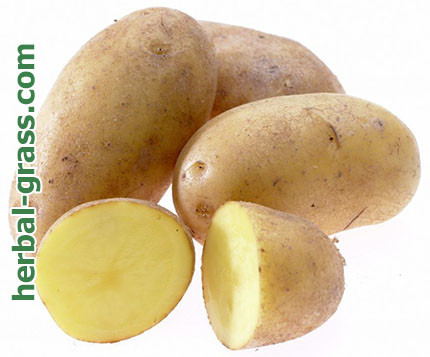
Potatoes - medicinal properties and use
Potato juice has long been treated for ulcers of the stomach and duodenum. And potassium, which potatoes are rich in, is simply necessary for patients with heart and kidney diseases. Used for medicinal purposes and the starch of this wonderful natural gift. So, it is used as an enveloping, anti-inflammatory agent for gastrointestinal diseases. Even with severe forms of poisoning, you can eat boiled potatoes.
Recipes
- Infusion of flowers. Three tablespoons of flowers pour 1.5 cups of boiling water. Insist in a thermos or a warm place for three hours.
- Corned beef tincture. More than 3 weeks to keep the potato tubers in the light - in the sun, until their surface becomes dark green in color and the inner flesh becomes bright green. Then the tubers need to be washed with water and together with the peel (in the peel and eyes contains the greatest amount of solanine), grate. From the obtained pulp, squeeze the juice, pour it into a bottle, add vodka in a 2: 1 ratio and let it stand for a week.
- Tincture of flowers. After 6 days after the potatoes bloom, collect potato flowers (the color does not matter), tightly tamp them in a glass jar to the brim. Pour flowers with vodka or alcohol. At the same time periodically shake the jar to get the air out. Close the jar with a lid and put it in a dark place for 20-25 days.
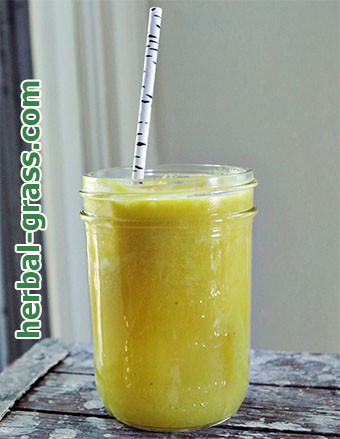
Photo of potato juice
ATTENTION!
Self healing is dangerous! Before treatment at home, consult your doctor.
Potato treatment
- Abscess. Apply fresh grated potatoes.
- Acne (eels) When phlegmonous acne will help a compress of peeled and grated raw potatoes, change every 2 hours.
- Angina. When starting angina, a compress of raw potatoes is very effective. 2-3 medium-sized potatoes wash, grate with the peel on a grater, put on a double folded gauze strip, sprinkle lightly with vinegar (not an essence!). Gauze folded and wrap throat with this scarf. Cover with polyethylene on top and wrap with a warm scarf or towel. Go to bed. Keep the compress for 4 hours, tightly pressed to the neck.
- Angina. Potatoes dried in the shade. 1 teaspoon of flowers in a clay pot pour boiling water - 1/4 cup. A pot can be put on top of a freshly boiled kettle and allowed to stand until it cools. Broth can or gargle, or lubricate it with a cotton swab.
- Angina (inhalation). Washed, unpeeled potato tubers put in a pan, pour water and cook until done. The steam is inhaled, bent over a saucepan with potatoes and covered with a sheet or blanket.
- Arthritis. For those suffering from gout, arthritis, arthritis, heel spurs, the following remedy will help: fill a jar of bright glass with seedlings of potatoes (choose the thickest and shortest, do not wash), lightly rub it. Open a jar to put on the window sill for 2 weeks, after this period, fill the jar with medical alcohol (a half-liter jar will need 300 g of alcohol), tightly close and place for a month in a dark place. Strain. Once a day before bed, rub the sore spots. One course of treatment lasts for 2-3 weeks due to well-being.
- Arthritis. 1 cup of sprouted potato sprouts up to 1 cm long, rinse, lightly dry, pour 0.5 liters of vodka, insist for 21 days, rub the sore joints with tincture.
- Arthritis of the hands. Take a raw, washed, but unpeeled potato, clamped in a fist. Put a mitten on your hand (so as not to drop it in your sleep) and sleep like that. It is not necessary to change the potato every time, you can use it until it germinates or frowns.
- Myopia. Dry in the shade the flowers of the potato. In a teaspoon pour clean, cold boiled water. Drown in it a dried flower. Hold the spoon over the candle until bubbles appear in the spoon (do not bring it to a boil!). Cool to the temperature of fresh milk and pipette two drops into each eye (no more!). There will be pain and tears in your eyes, but you have to be patient. Wipe your eyes with a clean handkerchief. The course of treatment from 2 weeks to 1-2 months. Do this procedure better in the morning. After 2-3 weeks, check your vision with a doctor. This method cleans the eyes, restores vision from - 3-5 to normal. During treatment, do not wear glasses and use a computer.
- Bowel disease. Drink 200 ml potato juice every morning 30 minutes before meals. The course of treatment is 10 days, repeat after 10 days.
- Warts. Keep your hands in a broth of potato peel. Then dry without wiping. The procedure for removing warts to do at night.
- Warts. Lubricate the wart with potato juice. On a half of a potato, on a cut to make two scratches, crosswise, to make the same scratch on a wart, to drop juice. Warts will disappear in 1-1.5 months.
- Warts. At night and all day to do a compress with a tincture of potato flowers. Flowers tightly put in a vial from under the medication, pour the top medical 70% alcohol, insist 10 days.
- Liver pain. For severe pain in the liver will help potato applications. Mash 0.5 kg of boiled potatoes in the jacket with the peel and place on a linen or linen cloth. Attach a hot potato pancake to the sore spot (it should feel pleasant heat) and wrap a warm scarf on top. Keep the appli cation until it cools down, then remove the potatoes, and again wrap the application in a warm place. Such procedures do within 3-4 days.
- Joint pain. Wash, dry and grate 3 potatoes on a coarse grater. The resulting slurry wrap in 3 layers of gauze and attach to the sore joint. Cover with polyethylene and wrap with a warm scarf. At the same time take the potato broth in the form of heat three times a day and 1 glass.
- Bronchial asthma. 15-minute inhalation over boiled potatoes with the addition of seed (2-3 tablespoons) or greens (a few twigs) allows to get rid of suffocation.
- Inflammation of the gastrointestinal tract. In the morning before meals, drink 1 glass of potato juice, then go to bed for 30 minutes, and after 1 hour you can have breakfast. The course of treatment is 10 days, repeat after 10 days.
- Gastritis. In the morning, before breakfast, cut out the eyes of 4-5 potatoes (no need to clean), then grate them, squeeze the juice, add 2 teaspoons of honey, stir and drink the whole batch, lie down for half an hour. Then you can get up and eat. The course of treatment: 10 days to take juice, 10 days rest, 10 days - take juice, 10 days - rest, 10 days - take juice. Exclude from the supply of fish, meat, fish and meat products.
- Chronic gastritis (with normal and increased secretion). Potato juice - half a cup, honey - 1 tablespoon. Fresh juice mixed with honey. Drink before meals 3 times a day. The course of treatment is 10 days, repeat the course after 10 days.
- Chronic gastritis (with normal and increased secretion). Drink in the morning fresh juice of potatoes in 100 ml.
- Hepatitis. When pains in the right hypochondrium do poultices of boiled potatoes with peel.
- Hypertension. Drink juice from one medium potato three times a day before meals. Total for the day to use 3 potatoes.
- Hypertension. Drink a decoction of potato peelings three times a day for a third cup.
- Hypertension. In case of hypertension, wash the potatoes of the variety “Sineglazka” thoroughly, boil them in the peel without salt. Drain the broth and drink 1 glass 3 times a day.
- Glossitis (inflammation of the tissues of the tongue). Rinse your mouth 2-3 times a day after eating with fresh potato juice.
- Dyspepsia. In the morning on an empty stomach, drink 1 glass of potato juice, then go to bed for 30 minutes, after 1 hour, have breakfast. The course of treatment is 10 days.
- Wen (lipoma). 1 tablespoon of dried flowers of potatoes pour 0.5 boiling water, insist in a thermos for 3 hours. Strain. Drink infusion 100 ml 3 times a day half an hour before meals. 10 days to drink, 5 days - a break. The course of treatment is 3-4 months.
- Malignant tumors of the internal organs. Take half a cup of infusion of flowers half an hour before meals three times a day. The course of treatment is 14 days.
- Heartburn with acidity. Drink potato juice 100 ml 3 times a day. The course of treatment is 10-12 days.
- Heartburn. In the morning before breakfast, cut out the eyes of 4-5 potatoes (no need to clean), then rub them on a grater, squeeze out the juice, add 2 tsp of honey, stir and drink the whole batch, lie down for half an hour. Then you can get up and eat. The course of treatment: 10 days to take juice, 10 days rest, 10 days - take juice, 10 days - rest, 10 days - take juice. Exclude from the supply of fish, meat, fish and meat products.
- Heartburn. If you suffer from heartburn, you need to chew and swallow a piece of raw potatoes.
- Coronary heart disease. 1 cup of flowers of potatoes (not subjected to chemical treatment from pests), wash and pour 0.5 liters of boiling water. Insist 30 minutes, strain and add 2 tablespoons of honey. Drink infusion of 1 tablespoon 3 times a day before meals.
- Cyst on the kidney. Chop the blue-eyed potato sprouts and put them into a 1-liter bottle, fill it up to 2/3, fill with vodka and leave for 3 weeks in a dark place. Strain and take 1 time a day, starting with 1 drop in 50 ml of water an hour before meals. Gradually adding drop by drop infusions, bring the dose to 30 drops in 150 ml of water and begin to reduce again to 1 drop. After a week break, repeat the treatment, but bring the dose to 40 drops. The next course is up to 50 drops. If necessary, courses can be continued by increasing the dosage to 100 drops. At the same time you can drink a decoction of burdock root (1 tablespoon to 1 cup of water, boil for 5-10 minutes).
- Mastitis. A few washed and dried potatoes rubbed on a fine grater, lightly squeeze and put gruel on his chest. Top cover with a clean cotton cloth, compress paper and a warm scarf. Compress to keep 2 hours. This treatment procedure is carried out 2-3 times a day for 2 days.
- Migraine. Potatoes are considered very effective against migraine. Our ancestors cooked potatoes in their uniforms and, with debilitating headaches, not only put warm potatoes on their foreheads, but also drank freshly prepared potato juice in a quarter cup 3 times a day 30 minutes before meals for a week.
- Uterine myoma
- Uterine myoma. Daily for six months in the morning on an empty stomach, take 1/2 cup of the juice of potatoes, and it is better that the potatoes be pink varieties.
- Corns. In the half-liter jar put the flowers of potatoes, pour vodka, insist 10 days in a dark place. Make lotion tincture on the corn.
- Frostbite. After restoring sensitivity, hold the sore spot in a warm, unsalted potato broth for 30 minutes.
- General cleansing of the body. To quickly and harmlessly cleanse the body of fungi and germs, bacteria, viruses - take 5 drops of tincture of solanine for 0.5 glass of water in the morning and evening 15-20 minutes before meals. After 5 days of taking a break for 5 days. Take 4-5 such courses immediately.
- Burns. Apply potato gruel.
- Oncological diseases. 1 tablespoon of potato flowers pour 500 ml boiling water, leave for 3 hours in a thermos, strain. Drink 1/2 cup 30 minutes before meals 1 time per day. The course of treatment: drink 4 liters of infusion!
- Acute dermatitis (due to sunburn). Put a compress of peeled and grated raw potatoes, change every 2 hours.
- Swelling under the eyes. Carefully washed potatoes grate on a fine grater. Take two slices of cheesecloth, put 1 tablespoon of grated potatoes on each and put them on eye bags for 10-15 minutes. After that, apply a cream for the skin around the eyes to the places of edema in the direction from the nose bridge along the lower eyelid to the temples. After 15-20 minutes, with cotton wool dipped in cold tea, remove the remaining cream. The procedure should be done 2 times a day - in the morning and in the evening.
- Swelling under the eyes. Boiled potatoes in half cut in half and apply to closed eyes for 30-40 minutes. The temperature of the potatoes should not be too high so as not to damage the skin.
- Salt deposits. 2 cups of potato flowers pour 0.5 liters of alcohol, bury in the ground, insist 10 days, drain. Wipe joints tincture.
- Cleansing the body. Take 5 drops of tincture of solanine in 0.5 glasses of water in the morning and evening 15-20 minutes before meals. 5 days to drink, 5 days - a break. Take 4-5 such courses of purification.
- Swelling of the feet. Grate peeled potatoes and apply to the sore spot for 20-30 minutes, wrapping it with a rough cloth.
- Otitis. 2-3 drops of tincture of solanine dripped into the ear, cover with a piece of cotton. The pains will go away. Repeat a couple more times for prevention.
- Pancreatitis. Every day, morning and evening, 2 hours before meals, drink 100-200 ml of freshly prepared juice from potatoes, and after 5 minutes - fresh kefir. Potatoes are better to take pink. Peel not to remove. Potato juice should be no more than 10 minutes! The course of treatment is 15 days, then a break of 12 days. Need to spend 3-4 courses. Green tubers should not be consumed; they contain the toxic substance solanine!
- Increased acidity. Take freshly cooked potato juice 3/4 cup three times a day on an empty stomach one hour before meals and before going to bed for 10 days, then take a 10-day break. The course of treatment is repeated. Attention! Juice can be prepared from July to January, while the potato has a low level of solanine.
- Gout. A jar of light glass entirely filled with sprouts of potatoes (choose the thickest and shortest, do not wash), slightly light. Open a jar to put on the window sill for 2 weeks, after this period, fill the jar with medical alcohol (a half-liter jar will need 300 g of alcohol), tightly close and place for a month in a dark place. Strain. Once a day before bed, rub the sore spots. One course of treatment lasts for 2-3 weeks due to well-being.
- Foot sweats. Powder dry potato starch with powdered legs.
- Cold. Do inhalation with a decoction of potato peel for 10 minutes.
- Rheumatism. Fill a half-liter glass jar with potato flowers, pour in alcohol, bury it in the ground for 10 days, strain. Lubricate sore spots at night.
- Rheumatism. Dry 10 g of potato sprouts, grind to a powder, pour a glass of vodka in a dark glass bowl, leave for 24 hours. In tincture, pour 0.5 cups of olive oil, shake. To rub the sore spots with the prepared means 2-3 times a day, wrapping them with a woolen scarf after the procedure. The procedure is recommended for whining pains.
- Erysipelas of the skin. Mashed raw potatoes put on cotton cloth and attach to the sore spot.
- Bruises. Cut plates of sliced potatoes to the injury site.
- Boils, pustular skin lesions. Put a compress of peeled and grated raw potatoes, change every 2 hours.
- Fibroma of the uterus. Pour in a thermos 1 hour a spoonful of dried potato flowers with one glass of boiling water. Thermos after 5-10 minutes to close and insist 4-5 hours. Drink infusion 3-4 times a day 30 minutes before a meal, 1/4 or 1/2 cup. The course of treatment is 1 month. Repeated course - in 1-2 months.
- Fibroma of the uterus. Daily take on an empty stomach for 1/2 cup of juice obtained from raw potato tubers. (if the patient does not have sombucous nodes and low acidity of gastric juice). The treatment is carried out from June to January: 1 month to drink juice, then take a break of 7-10 days. It is necessary to conduct 3 such courses.
- Fibroma of the uterus. 1 cup of flowers of potatoes (not subjected to chemical treatment from pests), wash and pour 0.5 liters of boiling water. Insist 30 minutes, strain and add 2 tablespoons of honey. Drink 1 tablespoon 3 times a day before meals.
- Furuncle. Put gruel of raw potatoes on a clean napkin and attach to the sore spot, fasten. Hold bandage for 2 hours.
- Spurs on heels. Grate the potatoes with the peel, put on gauze, cover with wax paper and pin on the sore spot. Do not remove this compress day! If necessary, repeat every other day.
- Eczema. For acute dermatitis due to sunburns and for pustular inflammation of the skin, a compress of cleaned and grated raw potatoes is used, changed every 2 hours.
- Duodenal ulcer. Take 1 / 2-1 / 3 cups of freshly prepared potato juice before meals in the morning and at lunch.
- Stomach ulcer. During the week, every morning, drink on an empty stomach 30-40 minutes before breakfast a mixture of half a cup of boiled warm water and a half cup of freshly squeezed juice of pink varieties of potatoes.
- Gastric and duodenal ulcer. In a fresh potato juice dissolve 1 tablespoon of honey. Drink half a cup 3 times a day. The course of treatment is 12-14 days, repeat after 10 days.
Potatoes - recipes of traditional medicine:
- Analgesic effect has a compress of grated raw potatoes with honey with osteochondrosis. This compress is kept on the sore spot for at least an hour.
- With hypertension often eat baked potatoes "in uniform".
- For swelling of the hands org should peel the potatoes, grate it, apply the potato slurry to the swollen places and hold for 15-20 minutes, tightly wrapping the “compress” with a cotton or terry towel.
- Potato Mask Recipe: Cook “Potato tenderness” for which you will need a pair of boiled tubers. Mash and mix them (hot) with one yolk, 1 tsp. honey, a small amount of vegetable oil (preferably olive oil). Apply the resulting mass on your face, and then rinse with boiled water. After this moisturizing and softening skin of a potato mask, lubricate your face with a nourishing cream. Lovers of natural cosmetics, I think, will probably come in handy with this recipe: mix medium boiled potatoes with 1 tbsp. l fresh curd and add 0.5 tsp. honey and half raw eggs. Then apply the finished gruel on the skin of the face and neck. Cover with a gauze cloth and hold the mask for 20 minutes, then rinse with warm water. Such masks are useful to do 1-2 times a week for 4-6 weeks. After 2 months, the course should be repeated.

Sprouted potatoes - harm to health
Contraindications. Potato tubers, only dug out of the soil, do not contain the poisonous alkaloid of solanine. But when storage technology is violated, when light hits the tubers, they form a poison that can cause symptoms of severe poisoning. Greened potatoes are contraindicated for ingestion. People with diabetes and other serious illnesses should consult a doctor about the amount and feasibility of eating potatoes.
Potato, or tuberiferous nightshade, is a perennial tuberiferous plant from the flowering department, dicotyledonous class, succulent-colored order, family of nightshade, of the genus of nightshade.
The name "potato" (lat. Solanum tuberosum), by which the plant man today knows this plant (vegetable), was suggested by Caspar Baugin in 1596. The Italians, because of the resemblance of the fruit bodies with potato tubers, began to call them "tartuffoli" or "tartufo". From this word, the German version of the name of the underground fruits “Kartoffel” was formed, which gave the Russian name.
Potatoes - description and appearance. The structure of plants and vegetables.
The number of stems in one plant ranges from 4 to 8-10. Their height, depending on the potato variety, may not exceed 30 cm or reach 1.5 meters. On erect fleshy stems of green (sometimes with a brown tinge), colors clearly stand out peculiar ribs. Dark green leaves of potato on short petioles spiral-shaped rise from the base to the top.
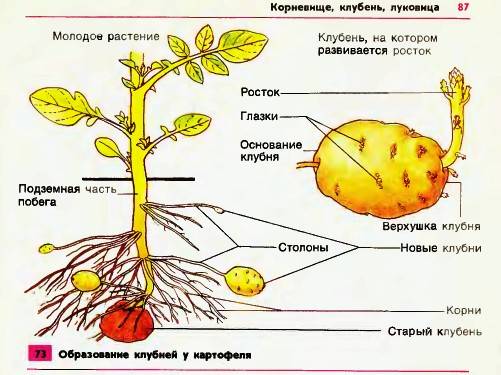

From the part of the stem of potato submerged in the ground, shoots (stolons) diverge in different directions, the length of which can reach 0.5 m. At their ends are potato tubers, the thin outer shell of which is formed by cork cloth. On their surface there are grooves called eyes. They contain several buds, from which a new plant develops. The flowers of the plant, collected on the top of the stems, are usually white. However, there are varieties with pink, blue or purple flowers. Below you can see how the potato stalk looks like, as well as the detailed structure of the potato.
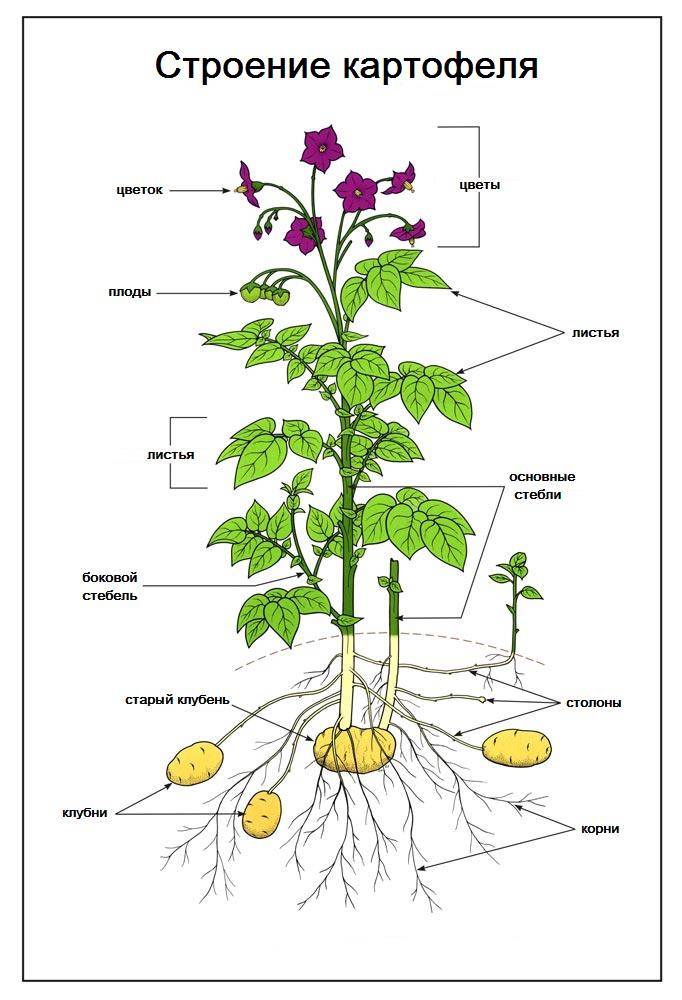
The elevated fruit of the potato is a poisonous green berry, resembling a miniature tomato. As it matures, it acquires a whitish hue.


Appearance, weight, color of the top layer of the potato tuber and its pulp differ depending on the variety. Tuber rind can be colored in various shades of brown, yellow, pink or purple. Therefore, the question of what color potatoes, a definite answer will not work.
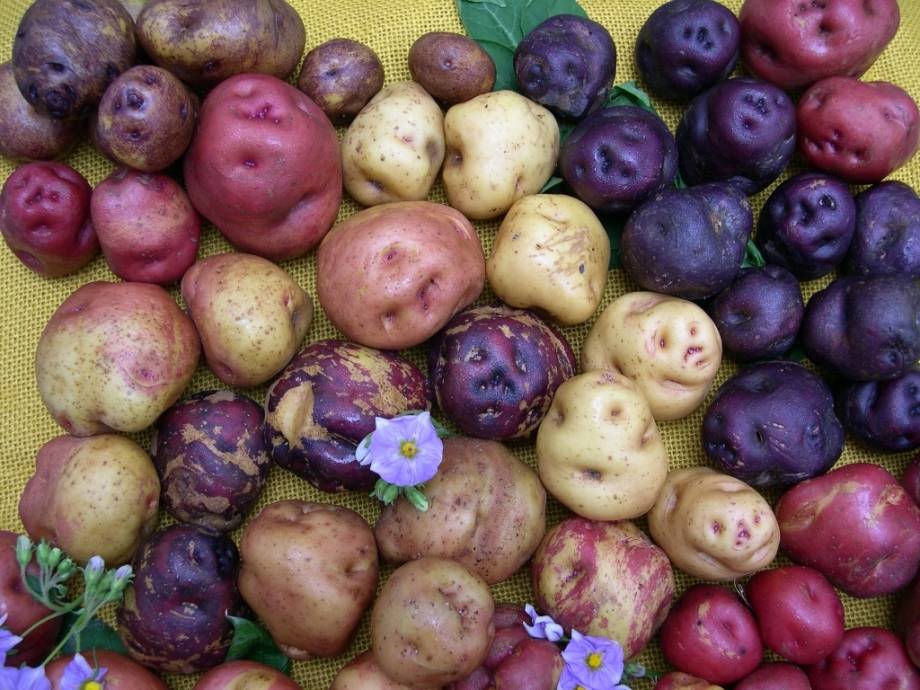
The flesh of the potato on the cut is usually white, but there are varieties with a dark yellow, cream or even purple, blue and pink color.


The shape of potato tubers is round, oblong, spherical or abstract, with protrusions and irregularities, and the weight of individual specimens can reach 1 kg or more.
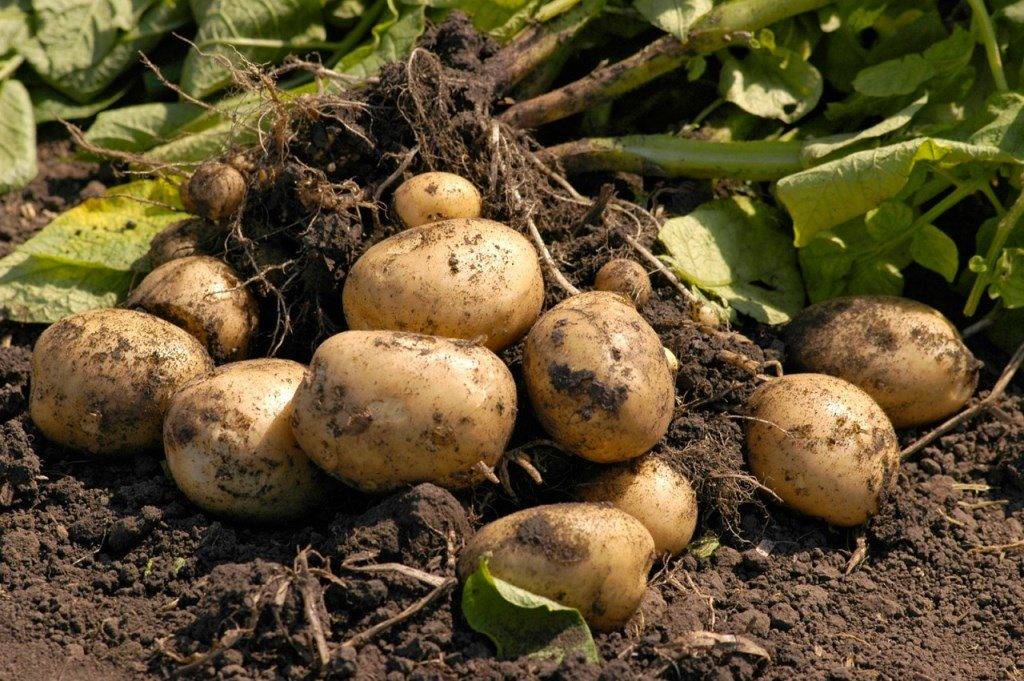
Potato varieties - photo and description.
Today, approximately 5,000 potato varieties are known. Of these, 260 were recommended for breeding in large farms and for private use in Russia.
For practical application, all varieties are divided into the following groups:
- “Felox” is a table potato variety with elongated tubers weighing up to 110 g. The flesh is colored light yellow, the skin is darker.
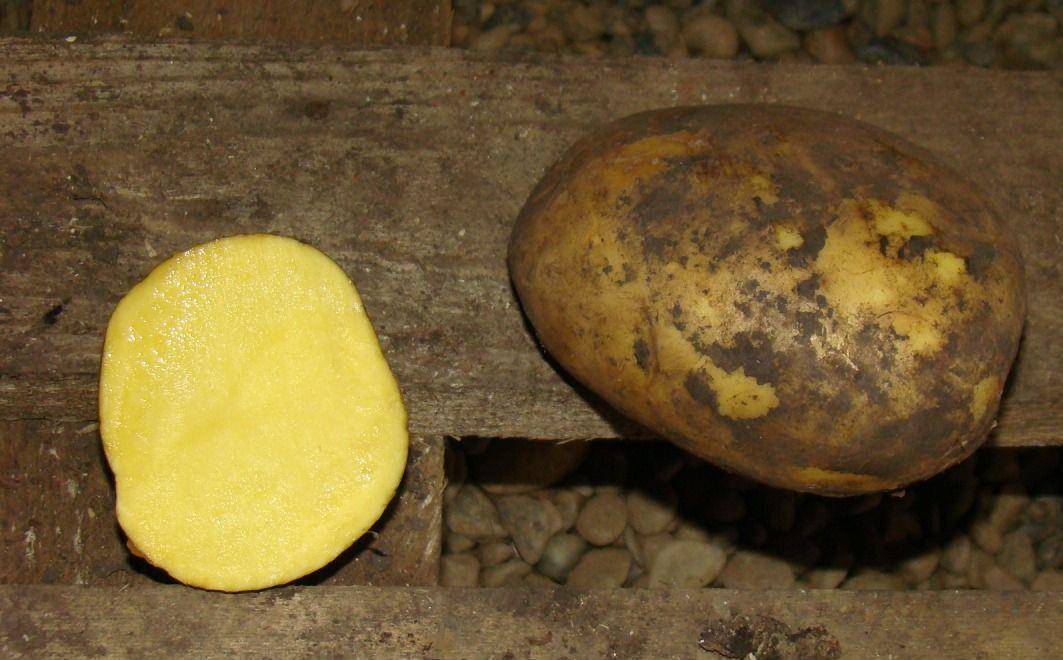
- Red Scarlett is a potato variety with oval tubers weighing up to 85 g. One shrub contains up to 23 potatoes with a smooth red skin and yellow flesh.

- "Nevsky" - potatoes with oval tubers with pink eyes and weighing up to 130 g. The top layer and flesh are white.
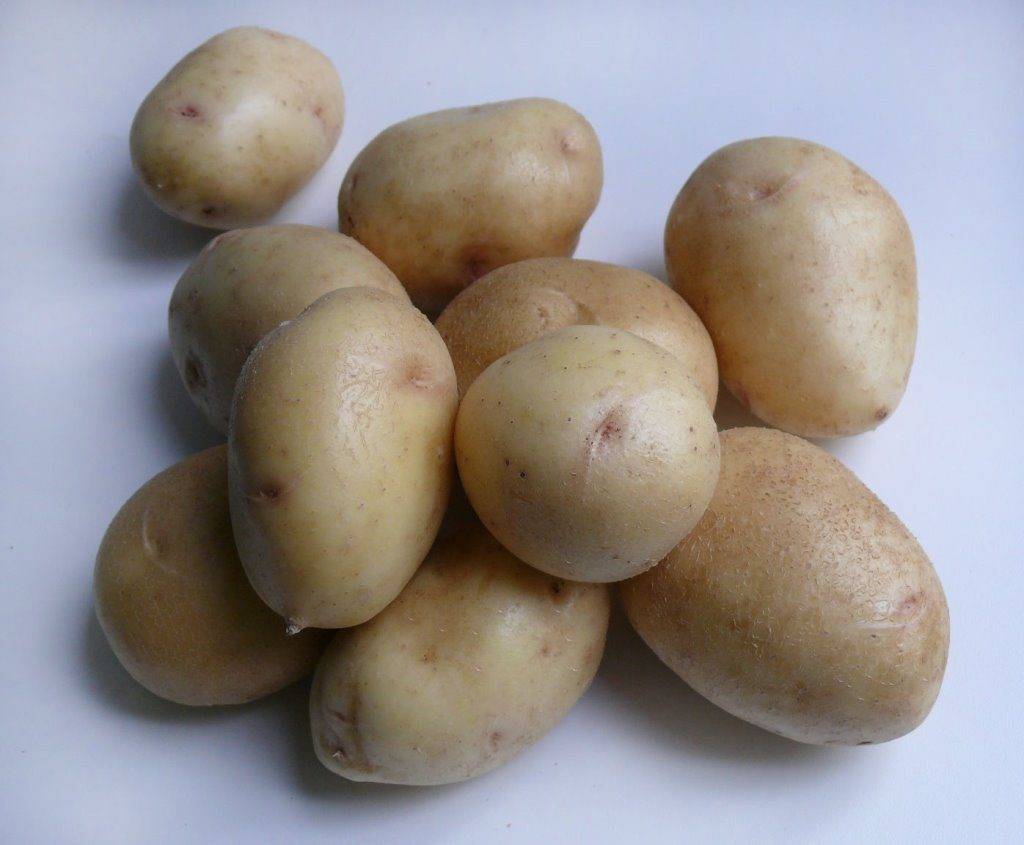
- “Vitalot” is a sort of purple potato, has oblong shaped tubers up to 10 cm long. It is highly starchy, it boils soft, retains its violet-blue color when cooked. Ripens late and has a low yield, so not grown on an industrial scale.
 Technical potato varieties - used as raw materials in the industrial production of alcohol and starch. Starch content in tubers exceeds 18%. Most often grown the following varieties:
Technical potato varieties - used as raw materials in the industrial production of alcohol and starch. Starch content in tubers exceeds 18%. Most often grown the following varieties:
- "Accent" - with large potatoes having a smooth yellow surface and flesh of light cream color.

- "Mountaineer" - medium sized potatoes. The peel of yellow color is covered with a fine mesh with numerous small eyes. Tuber on a cream-colored cut.

- “Outflow” - up to 10 potatoes weighing about 135 g can be under one bush. The surface of the yellow peel is covered with a rare mesh. The flesh is cream colored.
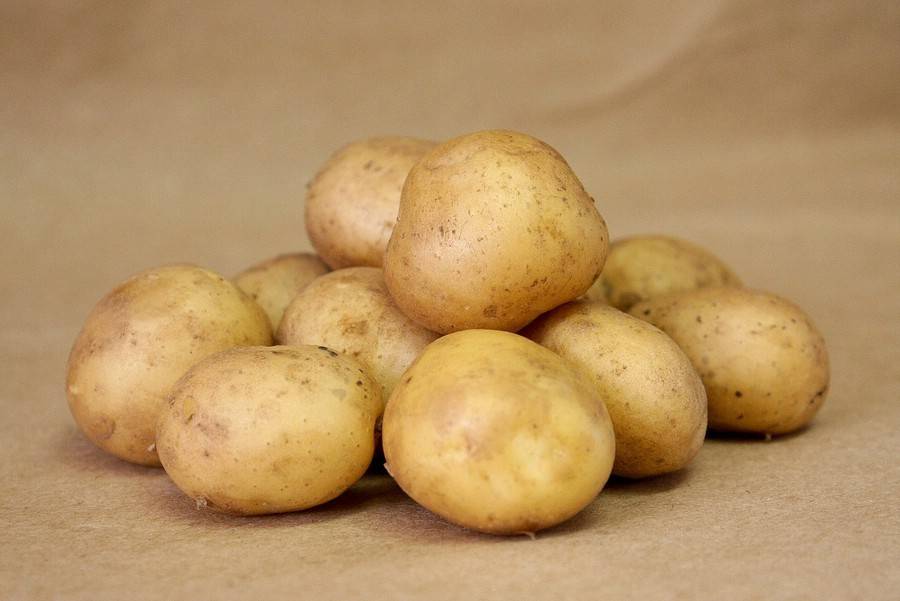
Feed Potatoes - used as livestock feed. A characteristic feature of fodder potatoes is the increased protein content, reaching 3%. Among them are the following varieties:
- Voltman is a fodder potato variety that has red tubers with numerous bright eyes and white flesh. Have an irregular angular shape.
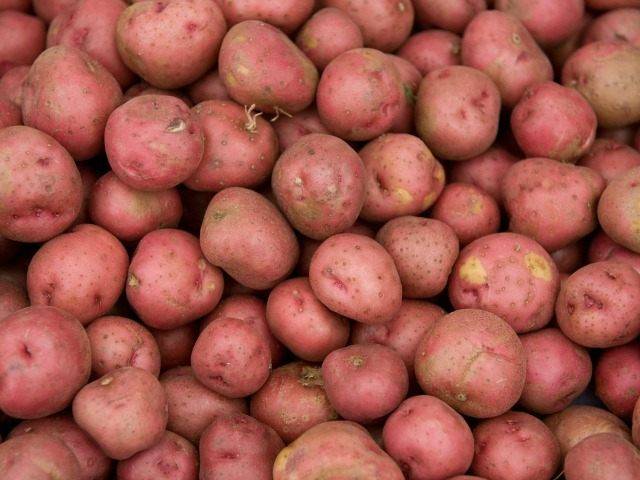
- “Lorch” - oblong tubers, covered with a smooth beige-skinned skin, have white flesh with a protein content of up to 2.2% and vitamin C up to 18%. Numerous shallow eyes are located on the entire surface of the tuber.

Universal Potato Varieties occupy an intermediate position between table varieties and potatoes, intended for technical use.
- "Berlihingen" - a variety of potatoes with red oval tubers. The skin is strong and thick with superficial eyes. The flesh is white when cooking darkens.
![]()
- Arosa is a variety with oval reddish tubers and yellow flesh. Stems sprawling with corollas of red-violet color.
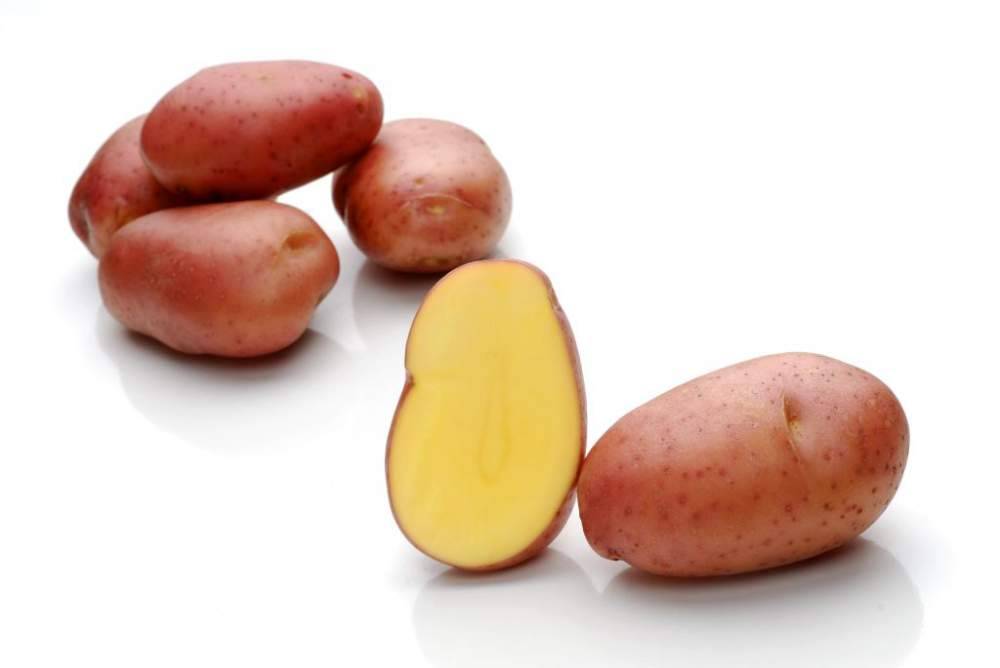
- "Sante" - has oval-shaped tubers with a peel and flesh of light yellow color.
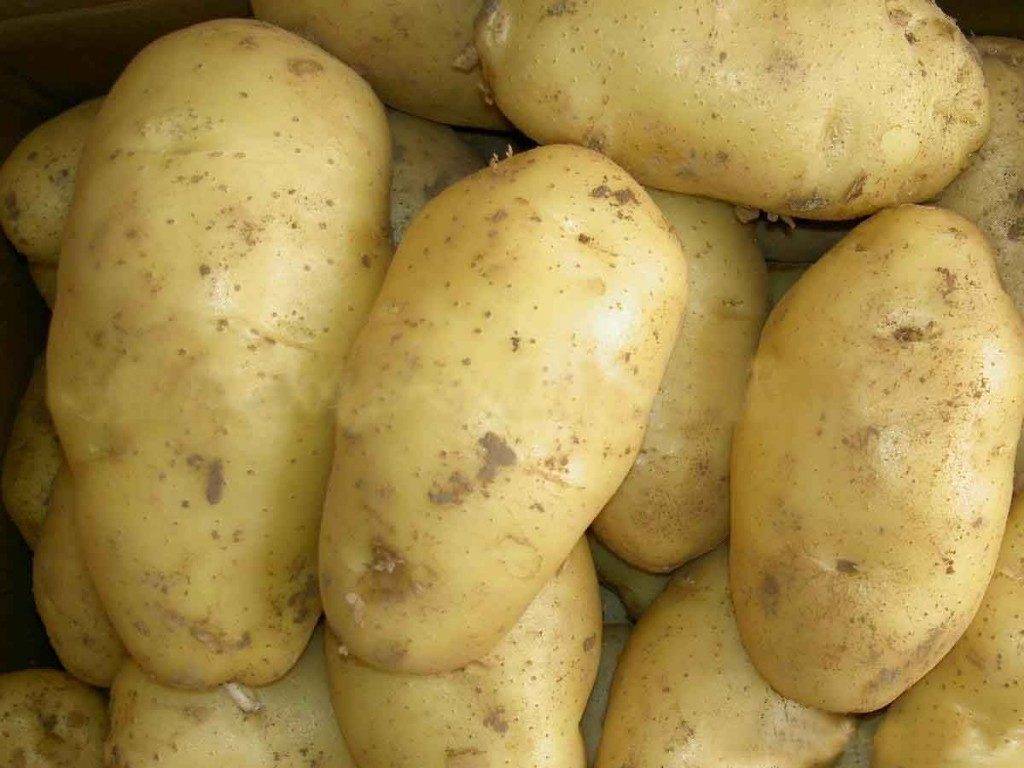
- Lasok is its medium-sized oval-shaped tubers with a light yellow-skinned skin and creamy flesh.
![]()
Maturity of potatoes.
There is a classification of potato maturity:
- Early potato varieties. The maturity of early potatoes comes after 50-60 days, so it is practically not intended for long-term storage. The following varieties are popular:
- Minerva;
- Ariel;
- Felox;
- Red Scarlett and others
- Mid-early potato varieties. For a good harvest of medium early potatoes, planting material is germinated in advance. The duration of the ripening period of this species is up to 80 days. The most popular varieties are:
- Carat;
- Santa;
- Adretta, etc.
- Mid-season potato varieties. The duration of the growing season of mid-season potatoes reaches 100 days. The following varieties are in great demand:
- Nevsky;
- Altair;
- Betina;
- Dewdrop and others
- Middle late and late potato varieties. The term of maturation ranges from 100 to 120 days. It is intended for long-term storage. Planting such planting material is possible without prior germination. Good results are obtained by planting such popular varieties as:
- Bernadette;
- Berlinger;
- Folva;
- Accent;
- Slavyanka, etc.


